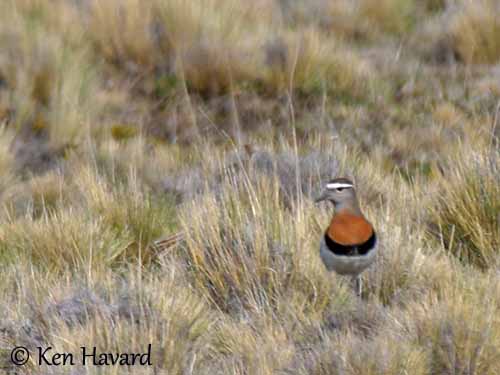
Fr: Gravelot d’Urville
All: Rotbrust-Regenpfeifer
Esp: Chorlito Chileno - Chorlito de Pecho Colorado
Ita: Corriere modesto
Nd: Patagonische Plevier
Sd: Rostbröstpipare
Photographers:
Ken Havard
My Bird Gallery & Flickr gallery 1 & Flickr gallery 2
Eduardo Andrés Jordan
MIS AVES – AVES DE ARGENTINA
Otto Plantema
Trips around the world
Text by Nicole Bouglouan
Sources:
HANDBOOK OF THE BIRDS OF THE WORLD Vol 3 by Josep del Hoyo-Andrew Elliott-Jordi Sargatal - Lynx Edicions - ISBN : 8487334202
BirdLife International (BirdLife International)
Neotropical Birds – Cornell Lab of Ornithology
Rufous-chested Plover
Charadrius modestus
Charadriiformes Order – Charadriidae Family
INTRODUCTION:
The Rufous-chested Plover is a monotypic species, although the Falkland’s birds have larger wings and legs, and could be recognized next day as a full species.
The contrasting breeding plumage is really beautiful.
DESCRIPTION OF THE BIRD:
Biometrics:
Length: 19-22 cm
Weight: 71-94 g
The adult in breeding plumage has greyish-brown upperparts, including wings and tail.
On the underparts, the breast is bright chestnut-orange with broad, contrasting black band on the lower edge. Rest of underparts are white.
On the head, the crown is brown, contrasting with a white supercilium which crosses the forehead. Face, chin and throat are ashy-grey.
The bill is dark grey to blackish. The eyes are dark brown, surrounded by narrow white eyering. Legs and feet are grey.

The female is slightly duller than the male.
The juvenile resembles non-breeding adult, with mostly darker brown breast and upperparts, and with pale buff fringes to feathers.
The non-breeding adult has creamy, not white, supercilium. Rufous and grey parts are mostly pale brown. The upperparts show pale-edged feathers.
RANGE:
The Rufous-chested Plover breeds in southern South America, in SC and S Chile, and WC and S Argentina, and also on Falkland Islands.
It winters northwards to N Chile and SE Brazil.
HABITAT:
The Rufous-chested Plover breeds usually inland, in short grassland, from sea-level up to 2000 metres on windy foothills, sometimes on dry stony areas around upland lakes, but also on coastal shingle.
On Falkland Islands, it frequents mudflats and estuaries, but it can be seen further inland, on heath and grassland too, where it often nests.
Outside the breeding season, it frequents flooded grassland, marshes, streams, mudflats and also beaches and rocky shores.

CALLS AND SONGS: SOUNDS BY XENO-CANTO
The Rufous-chested Plover, like most of Charadrius species, has soft voice, and can be heard mainly during the breeding season.
The display calls are fairly low-pitched, whereas the alarm call is high-pitched. The flight displays are accompanied by song. These displays are used during interaction between males, when they establish their territories. These displays can continue throughout day and night during the breeding season.

BEHAVIOUR IN THE WILD:
The Rufous-chested Plover feeds on wide variety of invertebrates such as insects and larvae, found in health and grassland. It also takes marine invertebrates such as crustaceans and molluscs, found in small rock pools.
When it forages near water, the Rufous-chested Plover is usually at water edge. Some feeding areas are often defended.
Outside the breeding season, they can be seen in flocks of up to 100 birds and sometimes more.

They have a socially monogamous mating system. They defend the territory and sometimes the feeding area too.
During the breeding season, displays and usual behaviour are often accompanied by calls or songs, such as flight displays and advanced courtship, or during nest building or nest defence.
The Rufous-chested Plover of the southernmost range migrate N in March/April, and return to the breeding range in August/September. However, some of them may remain in the vicinity of their breeding areas, even in Tierra del Fuego.
The birds of Falkland Islands reach the mainland after breeding, although some of them are resident on these islands.
They usually migrate in flocks. These long-distance migrations are performed with rapid and powerful flight.
REPRODUCTION OF THIS SPECIES:
The laying on Falkland Islands takes place between late September and mid-January, with peak in October.
The nest, a hollow in the ground, is placed in open area but among vegetation in heath or grassland for protection and cover. The Rufous-chested Plover is a solitary nester.

The female lays 2 eggs and both adults share the incubation. At hatching, the chicks are covered in golden-buff down with black spots and lines. The nape is rufous.
They leave the nest very soon and are able to feed themselves, but they still are under parents’ protection. The adults may perform distraction or “broken wing” displays to lead the predators away from the nest-site.
PROTECTION / THREATS / STATUS:
The Rufous-chested Plover is not globally threatened because it occupies areas with limited human impact. Currently, the population size is unknown.
The species is evaluated as Least Concern.
